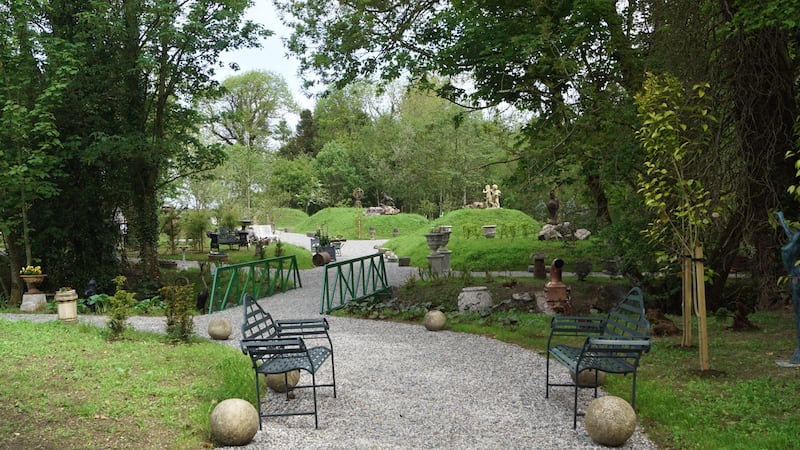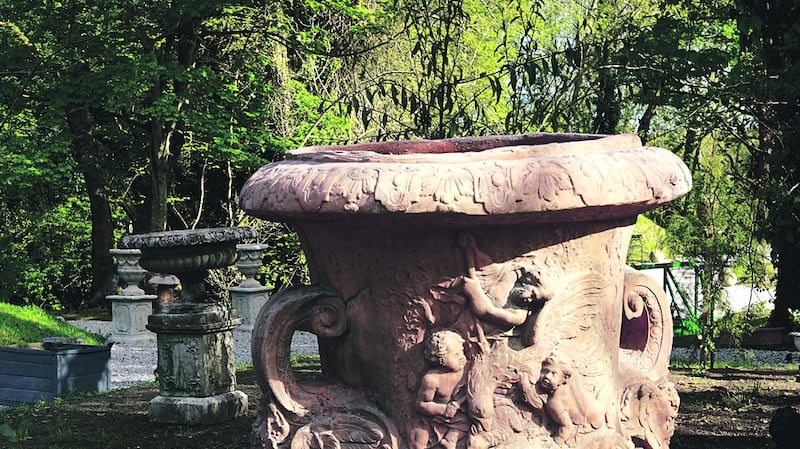A meandering path with leafy branches above and a carpet of wildflowers below; the music of birdsong and a rushing river; and, nestling among the greenery as if it had grown there of its own accord, a graceful terracotta amphora or perhaps a Gothic window arch. This effortlessly tousled look is what many gardeners aspire to, but it takes a lot of work to get it right. Sheppard’s, the auctioneering firm in Durrow, Co Laois, is well on its way to achieving it with a new garden which it has created on the banks of the river Erkina, just outside the town.
The idea was to create a suitably sylvan setting in which to display the items for their annual sale of garden furniture and statuary. “We used to sell them from the yard at the saleroom,” says Philip Sheppard, “but that was terrible. People couldn’t visualise how they would look in a garden setting.”

Last year they held the sale at Gash Gardens near Castletown. It was a great success, but the logistics of bringing numerous large and heavy objects into someone else’s garden – and, once the auction was over, out again – proved hugely demanding.
“So we had this site, and we’d been talking about a project like this for years, and we decided to go for it,” Sheppard says.
Designing the garden posed an unusual set of challenges. “We wanted to keep the wilderness feel of the adjoining woodland, which is full of bluebells and wild garlic, and where there are the ruins of a ninth-century monastery. But we also have to have proper paths so that members of the public can walk around in safety – and also so that we can get the statuary and bigger pieces in and out.”
Inspiration came from the historical document known as The Red Book of Ossory where, in the 1460s, the name Gleann Tulaigh, or “glen of the hillocks”, was used to refer to the area. This provided a name – Glantelwe Gardens – as well as the idea of using repeated tussocky forms to add height and texture to the space.
A six-storey mill which once operated on the site would have been a powerhouse of the local economy in the mid-18th century. After it closed in 1934, however, the main buildings had partly collapsed into the river – so the rest had to be demolished for safety reasons. But the miller’s house and grainstore have been restored, and two new purpose-built bridges at Glantelwe bring visitors to the heart of the gardens.
Unusual specimens
The input of garden designer Arthur Shackleton, who has made gardens at Butler House and Lacken Mill in Kilkenny as well as his own Fruitfield Farm in nearby Abbeyleix, can be seen in the planting of some very unusual specimen trees. Cretan maple and downy hawthorn are joined by a trio from the Far East; Chinese privet, Chinese crab apple and the spectacular Sorbus folgneri Emiel, aka Chinese rowan, which will provide a blaze of autumn colour.
Trees, of course, take time to establish in a garden. And though native wildflowers will happily sprout up in an instant where they’re not wanted, invite them to form a multilayered prairie look over a large area and they turn all slow-moving and coy. But even if the poppies and cornflowers aren’t yet in full flow, a walk around Glantelwe shows that it’s already a glorious backdrop for the objects which come under the hammer on Tuesday and Wednesday.
Standing guard at the entrance are two vase-shaped 18th-century limestone urns which came from a private collection in Cork (lot 1, €8,000-€12,000). A Victorian pillarbox from Cork’s Patrick Street (lot 2, €2,000-€3,000) looks resplendent placed in front of one of the old mill walls. A pair of terracotta Warwick urns (lot 78, €800-€1,200) are embellished with intricate decorative masks, while a group of playful stone putti wrestle on their plinth (lot 137, €1,500-€2,500).
To add focus to even the most modest garden vista it’s hard to beat an elegant sundial (lot 67, €1,400-€1,800). If you already have a sundial, you might be in need of a heliochronometer – which, as well as the sun, uses latitude, longitude, the direction of true north and the month of the year to tell the time (lot 72, €800-€,1,200). Animal-lovers can populate their garden with a stag (lot 419, €4,000-€6,000), a pair of imposing Italianate stone lions (lot 85, €3,000-€5,000) or a cheeky cast-iron rooster (lot 139, €400-€600).
Human figures range from an art deco-style bronze sculpture of an exuberant young woman, her arms flung skywards (lot 244, €1,500-€2,500) to a Dickensian 19th-century terracotta street urchin (lot 332, €2,000-€3,000).

The sale offers a large selection of statement pieces: jardinieres, millstones, skillet-pots, stone troughs, chimneypots and staddle stones. A pair of 20th-century mirror-glazed wooden doors (lot 126, €200-€300) would add depth to the smallest town garden; a lichen-covered boulder (lot 157, €300-€500) could double as a casual seating space. There are garden seats in all shapes and sizes, some incorporating horseshoe designs (lot 108, €800-€1,200). Rococo tables with marble tops (lot 110, €400-€600) are perfect for potting benches.
Glantelwe Gardens is open for viewing Saturday 26th, Sunday 27th, and Monday 28th, 10am-6pm. Factor in the time to stroll around the well-stocked walled kitchen gardens at Castle Durrow, a five-minute drive away, and the spectacular formal beds at Heywood, just up the road, and you have the makings of a great gardening day out.
Sheppard’s, The Square, Durrow, Co Laois. Sale of garden sculpture and architectural ornaments at Glantelwe Gardens, Mill Road Durrow, Tuesday May 29th, sheppards.ie













